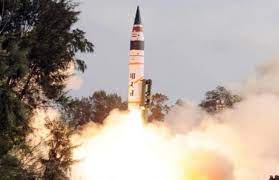By Girish Linganna
An observer on Abdul Kalam Island may have seen a missile launch on March 11, which may have appeared similar to previous launches. If the observer had paid closer attention, she would have noticed it was actually the tenth test of the Agni V missile, India’s first intercontinental ballistic missile capable of reaching the heart of China. The true significance of the launch was concealed within the nose cone of the missile and spectators wouldn’t have guessed it.
This month’s launch is believed to be the first instance in which India conducted a test of a missile equipped with Multiple Independently Targetable Re-entry Vehicle, also known as MIRV, which was created by the United States in the 1960s.These are compact warheads placed on a single missile, with each having the ability to hit targets that are several hundred kilometres apart. The test represents a significant achievement for Indian researchers in terms of technology.
According to experts Hans Kristensen and Matt Korda from the Federation of American Scientists, this development represents a notable advancement in India’s nuclear strategy, occurring more quickly than previously expected. It may also impact the nuclear balance in Asia, as reported by “The Economist.”
MIRV’s offer three benefits for India. Firstly, they provide the country with increased confidence that its nuclear warheads would be able to penetrate any potential Chinese missile defense system. Additionally, in the unlikely scenario that China or Pakistan were to eliminate a portion of India’s missiles in a surprise attack, a limited number of remaining missiles would still possess enough firepower to cause significant damage in retaliation.
The third advantage of the MIRV for India is that it enables the country to prioritize precision over sheer firepower. It is believed that India’s test of a thermonuclear bomb in 1998 was unsuccessful. With MIRV, India can utilize a greater quantity of less potent fission bombs to achieve the same impact as a single large hydrogen bomb.
According to Christopher Clary from the University at Albany in New York, there is an additional advantage. Clary said that missiles, particularly long-range, are usually more expensive than warheads. Therefore, significant cost savings could be achieved by utilizing MIRV to deliver the same number of warheads on target. This cost-effective approach would be appealing to India, given that its defense budget is considerably smaller compared to China’s. This information was also reported by “The Economist.”
Despite the benefits, there are downsides to the MIRV. They increase the possibility of initiating a “disarming” or “neutralizing” first strike against an adversary’s nuclear capabilities. Additionally, by consolidating multiple warheads into a single missile, an MIRV becomes attractive targets for an enemy’s first attack. This situation could lead countries to expand their arsenals and launch them more rapidly in times of crisis. The history of the United States and the Soviet Union “mirving” their missiles in the 1970s illustrates how this technology contributed to the arms race.
Ashley Tellis, a specialist at the Carnegie Endowment, a research organization in Washington D.C., has suggested that India is not particularly inclined to utilize MIRVs for targeting the nuclear missiles of China or Pakistan, a strategy referred to as “counterforce.” Tellis points out that India’s missiles may not possess the necessary accuracy for this purpose. To build confidence in its MIRV capability, India will likely need to conduct numerous additional tests, according to “The Economist”.
However, Kristensen and Korda express worry. They highlight that China has equipped some missiles with the MIRV, and Pakistan conducted MIRV tests in 2017. Additionally, there are discussions in the United States and Russia about reintroducing MIRV to missiles that were previously reduced to single warheads. They believe that a scenario where almost all nuclear-armed nations possess substantial MIRV capabilities would be considerably more hazardous. (IPA


